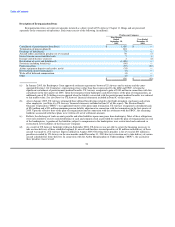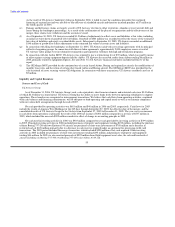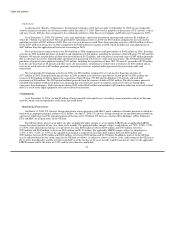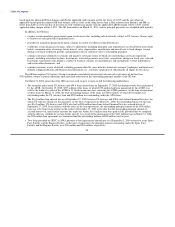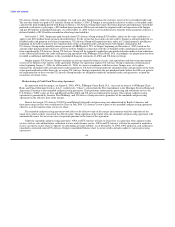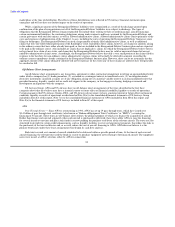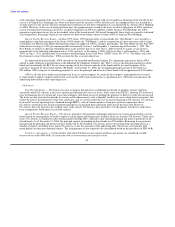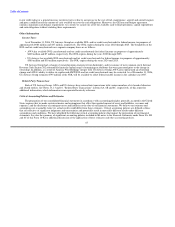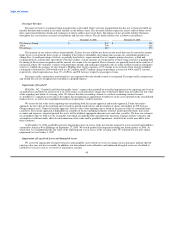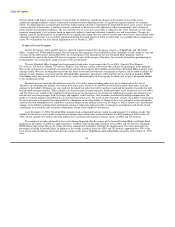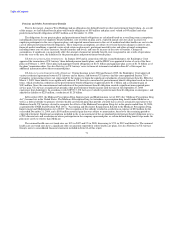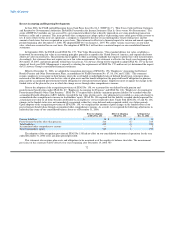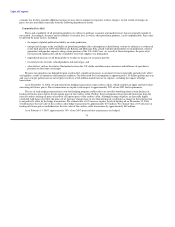US Airways 2006 Annual Report Download - page 67
Download and view the complete annual report
Please find page 67 of the 2006 US Airways annual report below. You can navigate through the pages in the report by either clicking on the pages listed below, or by using the keyword search tool below to find specific information within the annual report.
Table of Contents
marketplace at the time of distribution. The effects of these distributions were reflected in US Airways' financial statements upon
emergence and will not have any further impact on the results of operations.
While a significant amount of the Reorganized Debtors' liabilities were extinguished as a result of the discharge granted upon
confirmation of the plan of reorganization, not all of the Reorganized Debtors' liabilities were subject to discharge. The types of
obligations that the Reorganized Debtors remain responsible for include those relating to their secured financings, aircraft financings,
certain environmental liabilities, the continuing obligations arising under contracts and leases assumed by the Reorganized Debtors and
certain grievances with our labor unions, as well as allowed administrative claims. Allowed administrative claims consist primarily of the
costs and expenses of administration of the Chapter 11 cases, including the costs of operating the Reorganized Debtors' businesses since
filing for bankruptcy. The Reorganized Debtors received a large number of timely filed administrative claims, as well as additional
claims that were late filed without permission of the Bankruptcy Court. Included in these claims, however, are claims for amounts arising
in the ordinary course that have either already been paid, or that are included in the Reorganized Debtors' business plan and are expected
to be paid in the ordinary course. Also included are claims that are duplicative, claims for which the Reorganized Debtors believe there is
no legal merit for a claim of any status, and claims that the Reorganized Debtors believe may be valid as unsecured claims but are not
entitled to administrative claims status. Accordingly, the Reorganized Debtors believe that only a very small portion of the claims filed in
response to the bar dates for non-ordinary course administrative expense claims will actually be allowed in amounts exceeding the
ordinary course expenditures already contained in the Reorganized Debtors' business plan. However, there can be no assurances that the
aggregate amount of the claims ultimately allowed will not be material. To the extent any of these claims are allowed, they will generally
be satisfied in full.
Off-Balance Sheet Arrangements
An off-balance sheet arrangement is any transaction, agreement or other contractual arrangement involving an unconsolidated entity
under which a company has (1) made guarantees, (2) a retained or a contingent interest in transferred assets, (3) an obligation under
derivative instruments classified as equity or (4) any obligation arising out of a material variable interest in an unconsolidated entity that
provides financing, liquidity, market risk or credit risk support to the company, or that engages in leasing, hedging or research and
development arrangements with the company.
US Airways Group, AWA and US Airways have no off-balance sheet arrangements of the types described in the first three
categories above that they believe may have a material current or future effect on financial condition, liquidity or results of operations.
Certain guarantees that US Airways Group, AWA, and US Airways do not expect to have a material current or future effect on financial
condition, liquidity or results of operations are disclosed in Note 10(e) to the consolidated financial statements of US Airways Group
included in Item 8A of this report, Note 7(e) to the consolidated financial statements of AWA included in Item 8B of this report, and
Note 8(e) to the financial statements of US Airways included in Item 8C of this report.
AWA
Pass Through Trusts — Since AWA's restructuring in 1994, AWA has set up 19 pass through trusts, which have issued over
$1.4 billion of pass through trust certificates (also known as "Enhanced Equipment Trust Certificates" or "EETCs") covering the
financing of 54 aircraft. These trusts are off-balance sheet entities, the primary purpose of which is to finance the acquisition of aircraft.
Rather than finance each aircraft separately when such aircraft is purchased or delivered, these trusts allow AWA to raise the financing
for several aircraft at one time and place such funds in escrow pending the purchase or delivery of the relevant aircraft. The trusts are also
structured to provide for certain credit enhancements, such as liquidity facilities to cover certain interest payments, that reduce the risks to
the purchasers of the trust certificates and, as a result, reduce the cost of aircraft financing to AWA. AWA does not believe it is the
primary beneficiary under these lease arrangements based upon its cash flow analysis.
Each trust covered a set amount of aircraft scheduled to be delivered within a specific period of time. At the time of each covered
aircraft financing, the relevant trust used the funds in escrow to purchase equipment notes relating to the financed aircraft. The equipment
notes were issued, at AWA's election, either by AWA in connection
64


